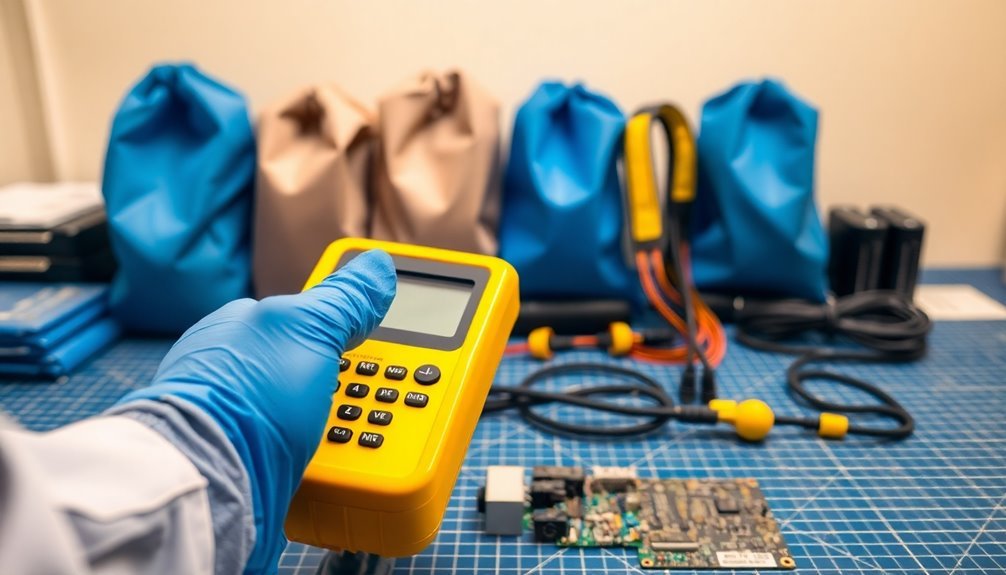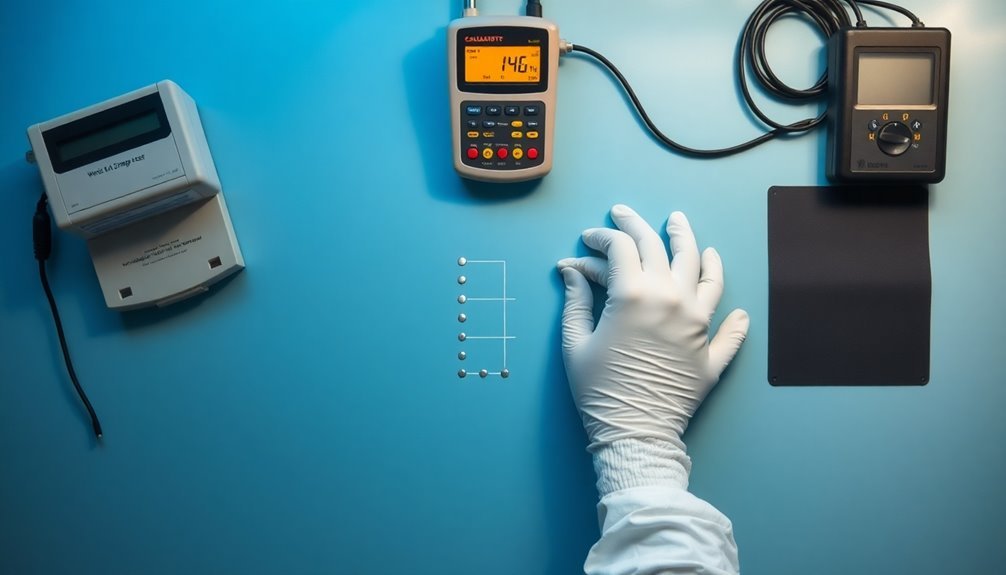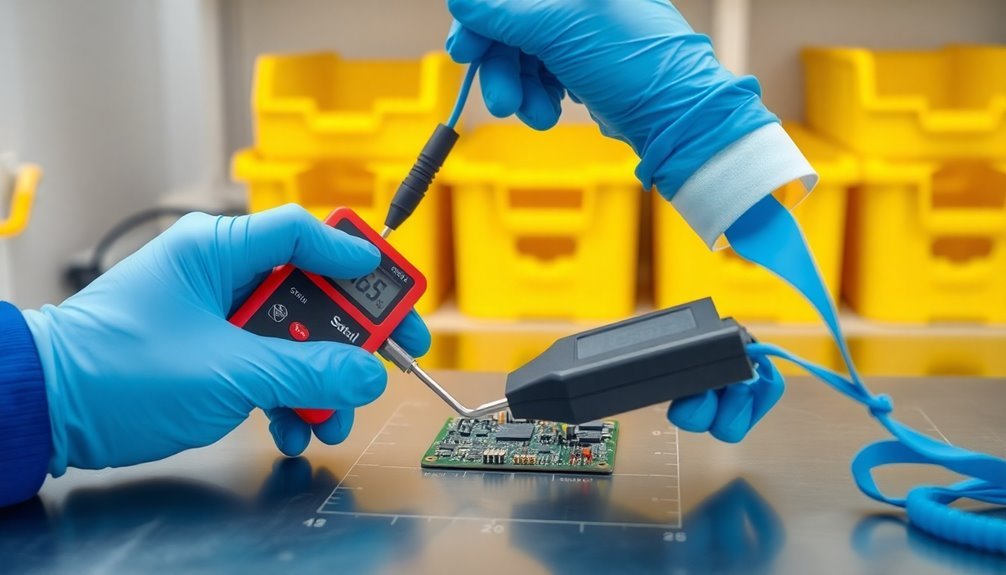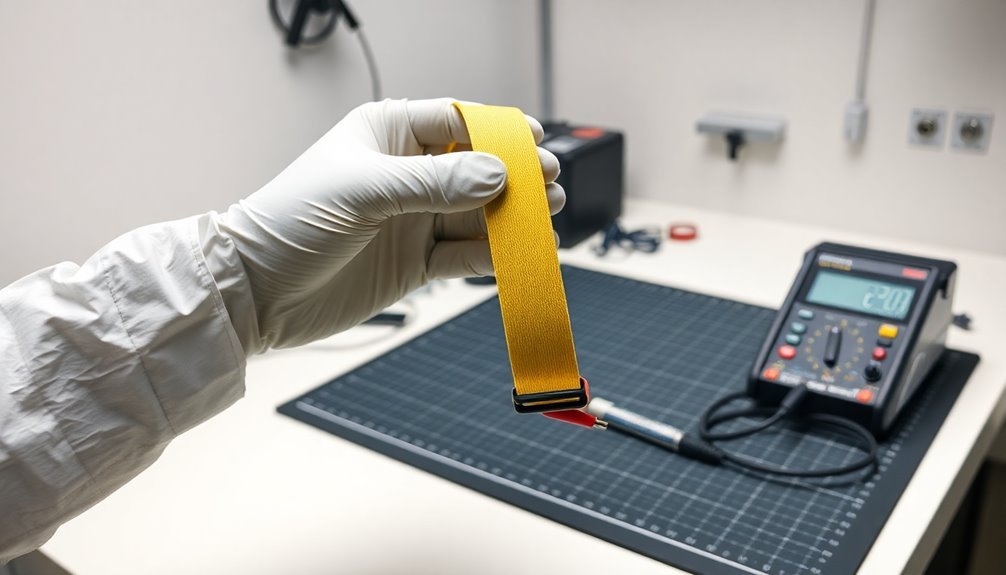To conduct a thorough static control audit, you'll need to follow a structured verification process. Start by establishing clear objectives and documenting your audit scope. Next, assess risks and map existing controls using frameworks like SCF. Implement testing methods including resistance testing and walking body voltage tests, ensuring measurements fall within 1.0 x 10E6 to 1.0 x 10E9 ohms. Document your findings meticulously and create corrective action plans for any issues discovered. You'll need to monitor performance continuously and report results to stakeholders. This systematic approach forms just the foundation of a detailed static control program.
Audit Preparation and Documentation Framework

A well-structured audit framework serves as the cornerstone of effective static control evaluation. You'll need to start by establishing clear, measurable objectives that define why you're conducting the audit and what specific risks you're addressing.
Your framework should outline the scope, methodology, and expected outcomes while adhering to relevant auditing standards. Regular engagement with SMEs helps validate control requirements and testing approaches. You must document every step of your planning phase meticulously.
Create a thorough audit plan that details your procedures, control objectives, and testing methods. You'll want to review existing system documentation, including development lifecycle documents, to understand the control environment thoroughly.
Make sure your documentation meets established standards like PCAOB AS 1215. When mapping out your framework, you'll need to identify key controls and link them directly to the risks they mitigate.
Consider how you'll test each control's effectiveness through methods like inquiry, observation, and inspection. Your documentation should clearly show how these controls address specific operational, security, or fraud risks.
Remember to include plans for evaluating control attributes such as frequency and impact, as these will influence your testing approach and final recommendations.
Risk Assessment and Control Mapping
Building on your established audit framework, risk assessment and control mapping form the backbone of your static control evaluation process.
You'll need to start by identifying inherent risks through workflow analysis and regulatory reviews, then classify them into high, medium, or low categories based on their potential impact and likelihood of occurrence.
To effectively manage these risks, you'll want to map your existing controls using a thorough framework like the Secure Controls Framework (SCF). Senior management should actively promote a control-conscious culture throughout the organization.
Focus on centralizing your data and cross-mapping controls to eliminate redundancy. This approach helps you test once and comply with multiple standards, reducing audit fatigue and streamlining your compliance management efforts.
You'll need to evaluate your identified risks against your organization's predefined risk appetite and tolerance thresholds.
This comparison will help you determine which risks require immediate action and which fall within acceptable parameters.
Remember to maintain continuous review of your assessments and control mappings to guarantee they remain effective.
Through proper control mapping, you'll increase transparency, improve efficiency, and gain a clear picture of your current risk posture without relying on assumptions.
Testing Methods and Instrumentation

Three essential components form the foundation of effective static control testing: proper methods, reliable instrumentation, and consistent documentation.
You'll need to implement both resistance testing and walking body voltage tests to verify your ESD floor's performance. Start by using a multimeter and static test meters to measure electrical resistance and evaluate real-world conditions.
When conducting your audit, you'll need to ensure the resistance falls within 1.0 x 10E6 to 1.0 x 10E9 ohms for communications facilities. Use inquiry and observation techniques to understand how staff implements ESD controls, while examining maintenance records and test results for compliance.
Don't forget to perform moisture testing, as excessive moisture can compromise your floor's ESD integrity.
Your testing strategy should incorporate risk-based sampling, focusing on areas where static discharge poses the greatest threat. Make sure you're equipped with a complete ESD test kit, including moisture meters and specialized static testing equipment.
You'll need to document all findings using audit software tools, which will help you track trends and identify potential issues. Remember to implement continuous monitoring systems where possible, as they'll provide real-time data on your floor's ESD performance and help prevent static-related incidents.
Workplace Verification Procedures
Systematic workplace verification stands at the core of any effective ESD control program. You'll need to implement regular checks to guarantee your ESD control materials, equipment, and procedures meet specified requirements and function properly.
When conducting workplace verification, you should use sampling techniques rather than checking every workstation. Select representative work areas that'll give you an accurate picture of your overall ESD control implementation. It's essential to maintain detailed checklists to guarantee consistency and thoroughness during your audits.
You'll want to establish an audit frequency based on your facility's experience. If you discover compliance issues, increase the frequency of your checks. Conversely, you can reduce the frequency when you consistently find proper adherence to procedures. It's best to have a single auditor conduct these verifications to maintain consistency in assessment methods.
Don't forget to document everything thoroughly. Your records should include test results, observations, and any corrective actions taken. These documents aren't just for compliance purposes – they'll help you track trends, identify recurring issues, and make informed decisions about your ESD control program's effectiveness. Make sure to use proper test equipment calibration when conducting measurements to ensure accurate and reliable results.
Corrective Action Implementation

When you discover static control issues during an audit, you'll need to follow immediate response protocols to prevent potential damage to sensitive electronic components.
You should document each incident thoroughly and implement corrective measures using standardized tracking tools that capture both the nature of the static control breach and the specific remedial steps taken. A well-structured corrective action plan serves as an essential roadmap for implementing the necessary changes.
Your ongoing progress measurements must include regular checkpoints to verify the effectiveness of implemented solutions and to guarantee sustained compliance with static control requirements.
Immediate Response Protocols
Implementing effective immediate response protocols serves as the cornerstone of a robust static control audit system. You'll need to act swiftly when issues arise, following a structured approach to identify, analyze, and address problems effectively. Safety management systems are integral to maintaining effective control measures and ensuring continuous improvement.
| Action Step | Implementation Protocol |
|---|---|
| Issue Documentation | Document findings clearly with detailed descriptions and prioritize immediate concerns |
| Root Cause Analysis | Investigate underlying causes using systematic evaluation methods |
| Corrective Planning | Develop SMART action plans with specific timelines and responsibilities |
| Implementation | Execute corrective actions while monitoring progress and effectiveness |
| Verification | Test and verify solutions through follow-up audits and expert consultation |
Once you've identified issues, you'll need to maintain thorough documentation throughout the process. It's essential to assign clear responsibilities and establish realistic timelines for each corrective action. You should implement a robust monitoring system to track progress and verify the effectiveness of your solutions. Don't forget to align all corrective actions with regulatory standards and maintain quality control processes to prevent issue recurrence. Remember to keep stakeholders informed through clear communication channels and detailed documentation, ensuring you're prepared for future audits.
Tracking Progress Over Time
Success in static control auditing hinges on your ability to track corrective actions methodically over time.
You'll need to establish a thorough tracking system that includes clear frameworks, detailed implementation plans, and regular progress updates from responsible departments.
Start by developing specific milestones for each corrective action and assign clear responsibilities to team members. Integration with trust center features can enhance your security verification process.
You'll want to verify these actions through document reviews, interviews, and on-site inspections.
Don't forget to evaluate the effectiveness of implemented solutions and make additional recommendations if needed.
Set up detailed follow-up schedules with specific timelines, and monitor the status of each corrective action through systematic documentation.
You should conduct regular assessments to verify compliance and maintain transparency through clear, concise reporting to stakeholders.
Focus on continuous improvement by performing root cause analysis for each finding and developing targeted action items.
Your monitoring system should track progress effectively while maintaining thorough documentation.
Remember to regularly review and update the status of each action item, ensuring that ongoing compliance activities stay on track through persistent verification and adjustment of your corrective measures.
Performance Monitoring and Reporting
You'll need to establish clear metrics for tracking your audit performance trends, focusing on key indicators like audit lead time, exception rates, and mean time between audits.
To effectively monitor these metrics, you should implement automated tools and data analytics that can generate real-time assessments of your control effectiveness. This approach helps ensure that log data integrity is maintained throughout the audit process.
Your reporting methods must include detailed documentation of measurement data through standardized reports, ensuring transparency and accountability while communicating results to relevant stakeholders.
Tracking Audit Performance Trends
Effective static control programs rely heavily on tracking and monitoring audit performance trends over time. You'll need to establish clear performance metrics and KPIs that align with your audit objectives to measure program efficiency and effectiveness.
Regular trend analysis helps you identify patterns, detect issues early, and make data-driven decisions for program improvements.
To maintain an effective tracking system, you'll want to:
- Conduct regular performance audits and document findings in detailed trend charts
- Compare current metrics against established audit criteria to spot variances
- Implement corrective actions based on identified deficiencies
- Monitor the effectiveness of implemented changes through continuous feedback loops
Your audit reports should include thorough trend data that triggers necessary corrective actions.
It's essential to maintain detailed records that support quality control efforts and ISO 9000 compliance requirements.
When you're analyzing trends, focus on both short-term fluctuations and long-term patterns to develop actionable recommendations.
Don't forget to share performance insights with employees and top management regularly – their engagement is vital for maintaining program effectiveness and driving continuous improvement in your static control measures.
Measurement Data Reporting Methods
Proper measurement data reporting sets the foundation for a robust static control program. You'll need to structure your reports clearly and concisely, focusing on key findings, conclusions, and actionable recommendations from your static control audits.
Start by using data visualization techniques to present your measurement data effectively. Create graphs, charts, and tables that highlight critical performance trends and deviations from established benchmarks. You'll want to include statistical analyses that demonstrate the effectiveness of your static control measures over time.
When compiling your reports, make certain you're documenting both automated and manual data collection methods. Include sampling techniques used, measurement frequencies, and any relevant statistical parameters.
Don't forget to integrate stakeholder feedback and clearly outline the root causes of any identified issues.
Make your recommendations specific and actionable, detailing the steps required for implementation. You should also establish a clear timeline for follow-up actions and verification of corrective measures.
Remember to maintain transparency throughout your reporting process by documenting your methodology and data sources, enabling others to verify your findings and conclusions independently.
Frequently Asked Questions
How Often Should ESD Control Equipment Be Calibrated Between Audits?
You'll need to calibrate your ESD equipment every 6 months, though high-use environments may require quarterly checks. Don't forget daily checks for wrist straps and monthly tests for smocks between formal calibrations.
What Qualifications Should an Internal Static Control Auditor Possess?
You'll need a relevant bachelor's degree, ESD certification, quality management experience, and strong analytical skills. You should also understand electrical theory, industry standards like ANSI/ESD S20.20, and auditing practices.
Can Remote Audits Effectively Assess Static Control Measures?
You'll find remote audits can effectively assess static control measures through digital tools and real-time monitoring, though you may need to combine them with on-site visits for thorough evaluation of critical areas.
How Do Seasonal Changes Affect Static Control Audit Results?
You'll notice that seasonal changes greatly impact your static control audit results through fluctuating humidity levels, temperature variations, and changing equipment usage patterns. These factors can alter the effectiveness of your ESD protection measures.
What Insurance Considerations Are Necessary for Static Control Audit Programs?
You'll need coverage for equipment damage, liability protection, and compliance with regulatory requirements. Don't forget to evaluate self-insurance options and maintain adequate reserves for potential static-related incidents in your audit program.
In Summary
You've now mastered the key elements of conducting a thorough static control audit. By following this systematic approach to documentation, risk assessment, testing, verification, correction, and monitoring, you'll maintain an effective static control program. Remember, it's your consistent attention to these steps that guarantees workplace safety and protects sensitive equipment. Keep refining your audit process to match your facility's evolving needs.





Leave a Reply